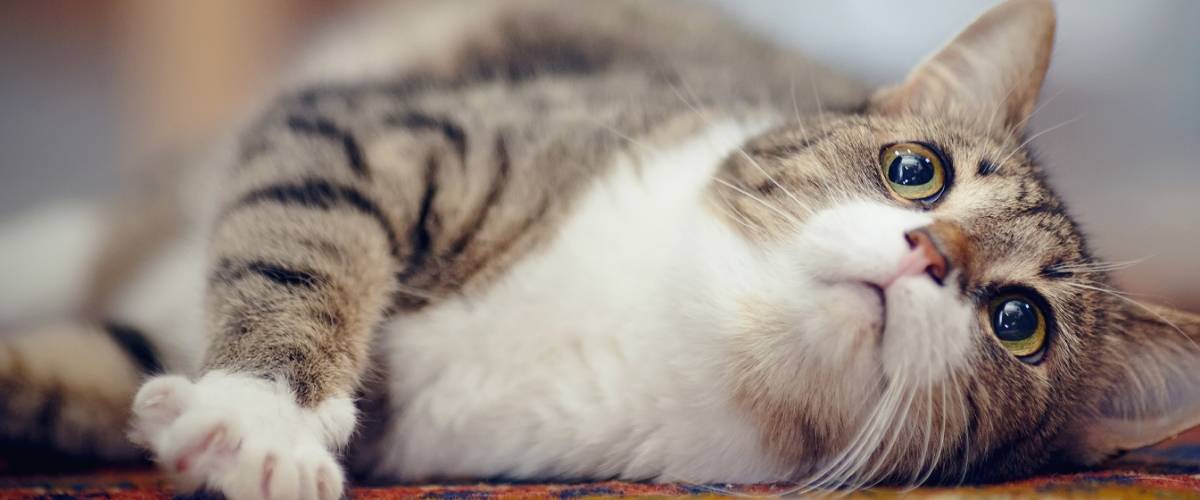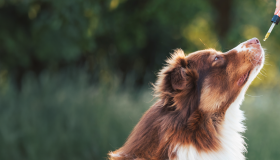
May 15, 2020 – Dr. Kelly Diehl talks with Dr. Vanessa Barrs, a virologist and Associate Dean and Director of Veterinary Affairs at the City University of Hong Kong. The two discuss feline viruses and Dr. Barrs’ Foundation-funded study on feline panleukopenia. They also dive into the topic of COVID-19, in relation to pets.
00:10 Dr. Kelly Diehl: Welcome to Fresh Scoop Episode 20: Update on feline viruses emerging and re-emerging diseases. I'm your host, Dr. Kelly Diehl, Morris Animal Foundation Senior Director of Science and Communication, and today we'll talk to Dr. Vanessa Barrs, a Morris Animal Foundation funded researcher and veterinary virologist. Dr. Barrs is the Chair Professor of Companion Animal Health, and Associate Dean and Director of Veterinary Affairs at the City University of Hong Kong. Fresh Scoop is our monthly podcast of the Morris Animal Foundation, one of the largest non-profit foundations in the world dedicated to funding studies to find solutions to serious health threats to animals. In each episode, we'll feature one of the researchers we fund or one of our staff members discussing their work in advancing animal health. Whether you're a practicing veterinarian, technician, or student, or just an animal-loving science geek, Fresh Scoop is the podcast for you. You can learn more about us at morrisanimalfoundation.org.
01:15 DD: Okay, on to today's show. Today, we welcome Dr. Vanessa Barrs. Dr. Barrs completed her Bachelor of Veterinary Science with honours degree at the University of Sydney, Australia. After graduation, she worked in small animal practice for several years before returning to her alma mater to specialize in medicine of cats. She became a fellow of the Australian and New Zealand College of Veterinary Scientists in 2000 and also completed a PhD, majoring in fungal infections at the University of Sydney. Dr. Barrs was the Head of the Department of Small Animal Medicine at the University of Sydney for 15 years and is now Chair Professor of Companion Animal Health and Disease at the Jockey Club College of Veterinary Medicine in City University of Hong Kong. And Dr. Barrs research interests, and the reason she's here today, include emerging and re-emerging infectious diseases of companion animals, and especially of cats. In 2012, she actually discovered a new species of fungus in cats, presented to the University Veterinary Teaching Hospital, and she's also a Morris Animal Foundation funded researcher and virologist. So, we're going to focus, actually, on virology today, and so Vanessa, thanks for joining us.
02:36 Dr. Vanessa Barrs: Thanks Kelly, it's a pleasure to be on the show.
02:38 DD: So, I gave an introduction but I always ask everyone, before we get into your work, a little bit about yourself... More personally and your background, why you decided veterinary medicine, and particularly, cats.
02:51 DB: Sure. Well, I'm an Australian, but I was born in the US, in North Carolina, and my dad was British, so I have three passports, which is handy for travel... although, that was back in the days when one could travel, of course. And I was always interested in studying veterinary medicine ever since I was small and I read a book called “All Creatures Great and Small”, which was pretty famous back in the day. And I became interested in cats because they have such interesting diseases and they like to hide their signs, so... I guess it was the detective work that really drew me to them. And they are such lovely animals. How could you not like spending your days with them?
03:40 DD: So I have a question on... You said something about infectious diseases, but when did you decide to really focus on that? Were there any defining moments for you?
03:52 DB: Yeah, I guess I was a feline medicine clinician or veterinary internist by training, so I've spent a lot of time in clinics, and I started to get really interested in infectious diseases through stuff that was coming through the door, different diseases that I was seeing like toxoplasmosis, and things like that. And one thing that really interested me was, back in the early '90s, when there started to be a lot of research coming out about cat-scratch fever, and identifying that cats were carrying this bacteria called Bartonella henselae. And that was something that really started to draw me into being interested in feline infectious diseases.
04:40 DD: Moving to the viruses, what are some unique features of feline viruses that you've studied that are really interesting?
04:50 DB: Sure. Well, I'm going to be talking a fair bit about parvoviruses today, so I think I have to start there, because they are tiny, tiny viruses. They've got a tiny small genome. They're only five kilo-bases of nucleotides long, they got a single strand of DNA, and yet they are incredibly resilient. They're really beautiful. They've got a little protein capsid that's in the shape of an icosahedral shape, and it's really hard to inactivate them. So, they're really environmentally resilient. I think that's a unique feature of parvoviruses and it makes them very hard to get rid of. Another thing that's really interesting about parvoviruses is that we've only really sort of become more aware of in the last, more recent years... Is the fact that the body never actually gets rid of a parvovirus and left behind is a tiny little footprint of its infection, because of the tiny amounts of viral DNA left behind in the white blood cells, in the monocytes of the blood.
06:04 DB: And so it's like a viral footprint of previous infection. And that makes them very easy to study, because you can always know if an animal has been infected by a parvovirus, not just by looking at serology alone, but you can also find the viral DNA, and you can also even culture the virus, from those samples. So, they're very interesting from that point of view. There's lots of other viruses around as well that I've been researching, and that have unique features, of course. There's the hepadnavirus, which was discovered by Professor Julia Beatty, one of my colleagues, and that was another Morris Animal-funded project. And we've found evidence that this hepatitis B-like virus in cats is associated with liver cancer. So, that's a unique feature of that virus.
06:58 DD: Yeah, I think for the folks who are listening, they probably know a little bit about feline leukemia virus, right? The classic sort of cancer-causing virus. And you alluded to another project funded by Morris where that was... That's been one of the things that you guys have looked for, which is cancer-causing viruses, other ones in cats. So I know there are folks listening who are probably old like me, and actually saw feline panleukopenia in practice many years ago, but it's... you know, it became sort of a rare entity until recently, and we'll talk about that. Can you discuss and just let people know who are listening what panleukopenia is in cats?
07:44 DB: Yeah, sure. So feline panleukopenia, it's a clinical disease syndrome that's caused by infection usually with feline parvovirus. It's also sometimes referred to as feline enteritis, and occasionally it's feline distemper. And it's actually the oldest viral disease known about in cats. It's been around for over a century, it's highly contagious. And it causes severe vomiting, diarrhea, immune suppression, and has a high mortality rate in cats especially in kittens. And in more recent years, we've come to understand that it's not only feline parvovirus that can cause feline panleukopenia, but also canine parvoviruses can cause this disease. Although in shelter situations there has not yet been any outbreak of feline panleukopenia that's been attributed to canine parvovirus. So they tend to cause more individual cases of disease rather than big outbreaks, so far anyway.
08:50 DD: And I think a lot of people probably who are listening are more familiar with canine parvovirus. I think they just have a better press agent, because we tend to hear a lot more.
[chuckle]
09:01 DD: And I think the names are confusing as you alluded to. When I was a kid it was called feline distemper, but it has nothing to do with canine distemper, right? It's really closer to, it's a parvovirus. So let's talk about your proposal, which is... Describe your project and the impetus for your project?
09:22 DB: Yeah, sure. So this project really is... The aim of this project was to determine what changes are present in the gut virome, or the community of viruses that inhabit the gut of cats that were diagnosed with feline panleukopenia compared to healthy controls. And really the impetus for this project was the re-emergence of feline panleukopenia where I was practicing in Australia. Similar to what you alluded to after a period of 40 years of no disease outbreaks being reported in shelters, suddenly this disease started popping up again in Australia. And you know, we reported losses of over a thousand cats during that epidemic re-emergence. So I really became interested to learn and investigate why this disease was reappearing. Was it just because of waning herd immunity or was it something else going on? And I really became interested to determine whether maybe there are other viral co-pathogens that could be causing disease. And so the aim of this project was really to look at the differences in the gut viromes, because that's where the viromes obviously, liked to replicate in diseased versus healthy animals.
10:44 DD: So what did you find, and did anything surprise you when you started to look into this?
10:51 DB: Yeah, sure. Well, let me... Can I just talk a little bit more about how we did this project? because I guess, the way that we investigate viruses has changed so much over the last 20 years. So back in the olden days people used to study viruses by culturing them. And now, of course, we have a huge array of molecular tools that enables us to look at the genetic code of viruses. And we also now can extract all the DNA, and all the RNA out of a tiny poop sample, and then amplify all of the viruses that are in that sample. So our ability to detect viruses has expanded hugely. And we also have the tools to be able to look at not just one virus but all virus, all infectious agents that are within the sample.
11:47 DB: So I guess this project really has been about using those tools to look at those differences between a healthy and diseased cats. And we use two different approaches. First of all, we looked at all the DNA viruses by doing something called metagenomics where we extracted the DNA, and then we enriched for detection of virus particles. And then we coupled that with a tool called metatranscriptor, and it's where we did direct RNA sequencing of all the RNA within the sample. And that combined approach gives us a very powerful tool to look at differences between the populations. And this is something that we also applied to another animal not too long ago, the endangered Tasmanian devil. And in that project we discovered 26 new viruses.
12:44 DB: So getting on to this project, we have generated a huge amount of data. And we are still analyzing our findings, we've still...we've got some preliminary findings at this stage, but we've generated such a huge amount of data that it's going to take us a little bit more time to understand all of the findings in this study. We've certainly found significant differences between the viromes of the healthy and diseased cats, and not just due to the presence of the feline parvoviruses in the diseased animals. In fact, we found a lot of different parvoviruses. We found parvoviruses, chapparvoviruses, and the feline dependoparvovirus.
[chuckle]
13:31 DB: And we got very excited because chapparvoviruses, chapparvoviruses, it's a little bit of a tongue twister. Chapparvoviruses have only recently been discovered in dogs. And we thought we'd just discovered them in cats as well as the dependoparvovirus, but just a couple of weeks ago another team from the University of California, Davis, put out a publication saying that they'd found these viruses.
14:01 DB: And I think that what we are finding is that these molecular tools enable us to keep discovering new viruses. And I think there will be thousands and thousands of new viruses that will be discovered by the sorts of investigations using these molecular tools. But really the key is having a good control population to try and work out, well what's the significance of these viruses? And many of the studies that have come out have not really had a good control population.
14:32 DB: So now we are drilling down into the actual differences between the abundance of those viruses between the two groups, and we are finding some surprising differences. So we're going to be able to release more of those findings a little bit further down the track when our data is analyzed a little bit more. And other than the parvoviruses we also found that the cats with feline panleukopenia had an abundance of both feline coronavirus and also feline astroviruses. And we also... we did actually find a novel astrovirus which we're hoping someone else won't scoop us to that publication.
15:16 DD: That sounds pretty interesting. So I have two follow-up questions. One is, I think people have heard a lot about the gut microbiome and they think of bacteria. So could you talk a little bit about what the virome is in general, when we talk about the gut virome?
15:37 DB: Yeah, sure. Thanks, Kelly, that's a great question. So it's exactly like the microbiome in that it is a community of viruses, rather than bacteria. And remember that that viral community includes things like bacteria versions. Still you know, we...our understanding of bacteria versions in cats, and its role in maintaining gut health is almost zero. But in addition to bacteria versions there are a large community of viruses. And you know, in many situations those viruses are completely innocuous. But sometimes, if something changes in the composition of the bacteria and the viruses together, etcetera, then you can start to see disease. So it's an important balance that maintains gut health.
16:31 DD: Okay, and you said the magic word coronavirus. And of course, we're just... We're talking from home. This is our second quarantine podcast. So nice segue into a little bit of more about feline virology. And so you mentioned the coronavirus that you found in the gut. So can you explain for the audience about feline coronaviruses that live in the intestine first?
17:00 DB: Absolutely. So I can reassure everyone listening here today that the coronaviruses that we find in the gut of cats are not SARS coronavirus 2 the cause of COVID-19, that's a betacoronavirus. The coronavirus in the gut of cats is an alphacoronavirus. So it's a completely different type of coronavirus, it's not infectious to humans. But it is the cause of feline infectious peritonitis which is a fatal disease in both dogs and cats worldwide.
17:37 DD: So what have you... I know you just... We were talking about this before we started recording about some... You've been... I've seen you a lot in the press, and you did a lecture for the World Small Animal Veterinary Association about of course, everybody's concerns about COVID. And we've been hearing a lot about... I mean, every day, right? And you're in Hong Kong, so of course, the infamous dog that was positive was the first one, was there in Hong Kong. So what are you seeing and hearing about animals "being tested positive for this virus?"
18:21 DB: Yeah, sure. Well, Hong Kong is fairly unique in that it's the only place in the world that actually quarantined animals belonging to COVID-19 infected patients and tested them for the presence of the virus. And the reason that Hong Kong did that was because in the SARS coronavirus outbreaks back in 2003, they did identify a small number of cats and possums that tested... Sorry, a small number of cats and dogs that tested positive for that original SARS coronavirus. So that's why they began testing. And back in 2003 when that SARS outbreak occurred there was no evidence of any animal to human transmission, and the animals that tested positive all were healthy.
19:07 DB: So this time around we can... You know, in addition to that one dog that made the headlines all around the world, that was a 17-year-old Pomeranian that did test positive for the virus, it was not contagious, and it wasn't sick. Since that time the AFCD here in Hong Kong has tested 52 animals including 32 dogs, 18 cats, and two hamsters. And of those animals only two dogs were infected and one cat, and none of them were sick, and all of them were sent home. And in terms of them being contagious to humans, well, only one of the dogs was viral culture positive. But I should stress that there's been absolutely no evidence of animal to human transmission of SARS coronavirus 2, the cause of COVID-19 anywhere in the world. And while there have been a couple of reports, as you know, of the virus being detected in cats in the US that did have mild flu-like signs. And also, there was a report of the tigers and the lions in the Bronx Zoo also having mild COVID-like signs and testing positive for the disease. So I guess what we can say is that it appears that cats are likely to be incidental hosts, but really, the way that humans catch COVID-19 is from humans.
20:51 DD: So that's actually... I'm going to ask you a question that I hadn't thought, but could be very helpful to people, is the distinctions between animals that may have the virus, but they're not really transmitting, and then sometimes, you can have the virus and not be sick. And can you... I know that's a huge, huge topic that I'm asking you, but maybe could you explain for us a little bit about the distinctions between infection and transmission, and we've heard words like amplification species sometimes bartered about, and we know that we talk about bats, but bats have it, but they don't get sick. So maybe make some distinctions of how animals could be positive, but not be really able to transmit.
21:45 DB: Sure. So I guess the key terms are infection, contamination and contagious. And an animal can be contaminated from its owner. So for example, if someone with COVID-19 sneezes on their dog, and you take a swab, there's a chance that there could just be a far more... And just be carrying that virus. They're not infected with the virus. An animal that is infected with the virus can be sick or it can be completely asymptomatic. And the way that you can confirm infection is usually by a blood test to detect for the presence of antibodies. An animal that is infected and that is asymptomatic may not be contagious because it may be shedding such a tiny, tiny amount of virus that is not contagious to humans. So either piece, that animals are... cats are not shedding the high amounts of virus as humans are.
22:55 DD: Okay, that's really helpful because I think that gets really confusing when people hear about these animals that have signs or whatever, is that doesn't mean necessarily that they can transmit it. So what do you think is next for you as far as your research and questions you'd like to look into in feline viral diseases?
23:19 DB: Sure, well, I guess following on from COVID-19, I will be doing some surveillance here for SARS coronavirus 2 in larger populations of cats and dogs, and also will be looking in Korea as well with some collaborators. And I guess one thing that, although we have no evidence that cats or dogs are involved in transmission of infection to humans, we just need to make sure that there's no evidence that the virus has become endemic, for example, in free-roaming outdoor cats. I don't think it has been. Surveillance is the cornerstone of our research. I think that's one question to be answered.
24:07 DD: For other research areas, I'm interested in respiratory viromes in cats and dogs in shelter environments. And I think there's a lot of work that can be done in that space as well, using these same molecular tools that we've used in this project, looking at viromes in the gut. I think there's a lot more to understand about what's really causing cat flu and what's really causing kennel coughing dogs, for example. Yeah.
24:37 DD: Yeah, it's pretty complicated, and I think... Have you seen evidence, and you alluded to this. We talk about the... there's a lot more on bacteria, and the bacteria in your gut might keep other bad guys out or in-track and things. Do you think a similar situation happens in the virome?
24:57 DB: Yeah, absolutely, absolutely. And I think that we're really learning at the tip of the iceberg. And one thing that we need to do is to really characterize what is normal. We still really don't understand what is normal because we have only very superficial data. So I'm really glad that this project is going to help us understand not only what is abnormal, but really get more of a baseline about what's normal.
25:25 DB: Okay, and my last question actually is circling back a little bit, to, I think I'll start with panleukopenia, which is you had... There was this outbreak and people, of course, vaccinate, or routine vaccinations, theoretically, should prevent it. What's sort of the take-home message from your research regarding how people can prevent or be careful about feline panleukopenia? And we have vets listening and cat owners as well.
25:58 DB: Sure, that's a great question. And the good news is that we didn't find any evidence of vaccine mutants, feline parvovirus mutants in our studies so far. So we know that feline parvovirus vaccines are highly effective and ultimately, prevention is better than cure. So keeping your cats' core vaccinations up-to-date is the most effective thing that you can do to prevent them from getting feline panleukopenia, and if everyone vaccinates their cats, then herd immunity will remain high and will reduce the risk of disease occurring for everyone, reduce the risk of outbreaks occurring.
26:39 DD: Good. And as far as the COVID-19 evolving situation, what do you tell people... you must talk to people who get worried. And I know you've spoken and published on this, but people get worried because they say, "Well, I hear I shouldn't worry. And then, darn it, those tigers and lions get infected. And then I think, as you alluded to, there was some experimental work in experimentally infecting cats. That gets out and people get really nervous about that. So what have you been telling people about their pets as we move through the pandemic?
27:19 DB: Yeah, look, I think that in terms of if you're a pet owner there is really nothing to fear, and nothing to worry about. I think that as pet owners we need to reinforce to other pet owners that owning a pet is a responsibility. There's nothing to fear. You're going to catch COVID-19 from humans, not from other animals. I think that in terms of if you're a healthcare provider, as a veterinarian, out of an overabundance of caution it makes good sense to continue with good infection control measures and in light of the finding of such a tiny percentage of animals, there are cats and dogs that have tested positive to the virus. So less than 6% of cats and dogs tested here in a high risk, high exposure environment have transiently tested positive for the disease, for the virus and none of them were sick. But out of an overabundance of caution, it makes sense to use good infection control guidelines when you are dealing with animals that are potentially from COVID-19 patients.
28:33 DB: And what I would say is that if any veterinarians are in that situation then there are excellent guidelines from the CDC and also from the AVMA on their websites about how to handle those animals. But if you're a pet owner you've really got nothing to fear. If you are infected with COVID-19 then the important thing is to social distance from your pet as well as from other people in your household again out of the over abundance of caution.
29:04 DD: That sounds really interesting. We'll stay tuned for more research from you. I'm looking forward to it. And Vanessa thanks so much for joining us today from Hong Kong, we negotiated the 14-hour time difference. And even though she refused to give me any stock tips because she's there in the future, that's okay. And we look forward to reading more of your work on this topic in the future.
29:31 DB: Thanks. Thanks so much Kelly. Thanks for having me on the show. It's been a pleasure.
29:35 DD: It was fun. So that does it for this episode of Fresh Scoop. Once again thanks to Dr. Vanessa Barrs for joining us and we'll be back with another episode next month that we hope you'll find just as informative. The science of animal health is ever-changing and veterinarians need cutting-edge research information to give their patients the best possible care and that's why we're here. You can find us on iTunes, Spotify, Google Podcasts and Stitcher and if you like today's episode, we'd sure appreciate if you could take a moment to rate us. That will help others find our podcast, to learn more about Morris Animal Foundation's work. Again, go to morrisanimalfoundation.org. There you'll see just how we bridge science and resources to advance the health of animals. You can also follow us on Facebook, Twitter, and Instagram. I'm Dr. Kelly Diehl, and we'll talk soon.




